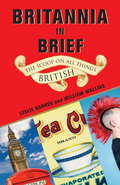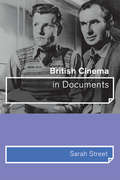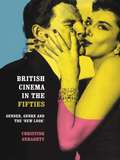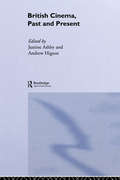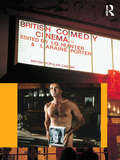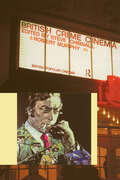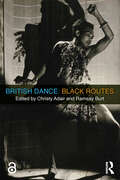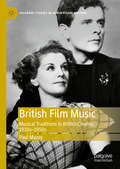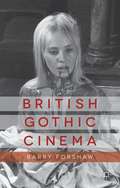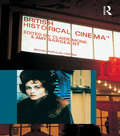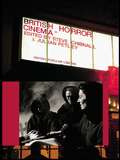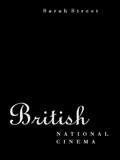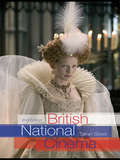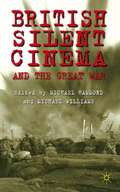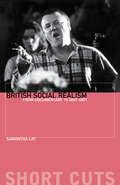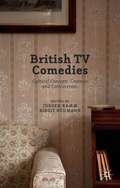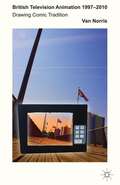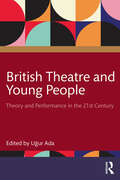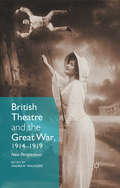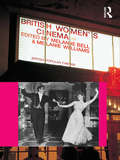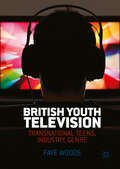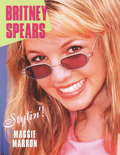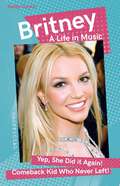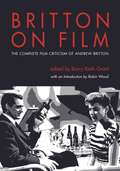- Table View
- List View
Britannia in Brief: The Scoop on All Things British
by Leslie Banker William MullinsFor travelers and anglophiles alike, this roundup of vital British culture is all at once clever, entertaining, and thoroughly useful.
British Cinema in Documents
by Sarah StreetBritish Cinema in Documents presents an introduction to the key concerns and debates in British cinema through documents, ranging from official papers to fan magazines. Sarah Street shows how such documentary material can enrich our understanding of cinema's place in national culture and shed new light on defining moments in British cinema history.Street draws together a wide range of material, discussing oral histories, film posters and stills and star memorabilia alongside audience surveys, censorship reports, fan magazines and web sites, providing a context for each extract she discusses. She uses a series of case studies, including film censorship during the Second World War, the fan cultures surrounding stars from Margaret Lockwood to Ewan McGregor, and surveys of the British cinema audience to illustrate how archival research can provide a new understanding of the relationship between a film and other kinds of texts, and between films, their audiences, and the state.
British Cinema in the Fifties: Gender, Genre and the 'New Look' (Communication And Society Ser.)
by Christine GeraghtyIn the fifties British cinema won large audiences with popular war films and comedies, creating stars such as Dirk Bogarde and Kay Kendall, and introducing the stereotypes of war hero, boffin and comic bureaucrat which still help to define images of British national identity. In British Cinema in the Fifties, Christine Geraghty examines some of the most popular films of this period, exploring the ways in which they approached contemporary social issues such as national identity, the end of empire, new gender roles and the care of children.Through a series of case studies on films as diverse as It Always Rains on Sunday and Genevieve, Simba and The Wrong Arm of the Law, Geraghty explores some of the key debates about British cinema and film theory, contesting current emphases on contradiction, subversion and excess and exploring the curious mix of rebellion and conformity which marked British cinema in the post-war era.
British Cinema, Past and Present
by Andrew Higson Justine AshbyBritish Cinema: Past and Present responds to the commercial and critical success of British film in the 1990s. Providing a historical perspective to the contemporary resurgence of British cinema, this unique anthology brings together leading international scholars to investigate the rich diversity of British film production, from the early sound period of the 1930s to the present day.The contributors address:* British Cinema Studies and the concept of national cinema* the distribution and reception of British films in the US and Europe* key genres, movements and cycles of British cinema in the 1940s, 50s and 60s* questions of authorship and agency, with case studies of individual studios, stars, producers and directors* trends in British cinema, from propaganda films of the Second World War to the New Wave and the 'Swinging London' films of the Sixties* the representation of marginalised communities in films such as Trainspotting and The Full Monty* the evolution of social realism from Saturday Night, Sunday Morning to Nil By Mouth* changing approaches to Northern Ireland and the Troubles in films like The Long Good Friday and Alan Clarke's Elephant* contemporary 'art' and 'quality' cinema, from heritage drama to the work of Peter Greenaway, Derek Jarman, Terence Davies and Patrick Keiller.
British Comedy Cinema (British Popular Cinema)
by Laraine Porter I. Q. HunterBritish comedy cinema has been a mainstay of domestic production since the beginning of the last Century and arguably the most popular and important genre in British film history. This edited volume will offer the first comprehensive account of the rich and popular history of British comedy cinema from silent slapstick and satire to contemporary romantic comedy. Using a loosely chronological approach, essays cover successive decades of the 20th and 21st Century with a combination of case studies on key personalities, production cycles and studio output along with fresh approaches to issues of class and gender representation. It will present new research on familiar comedy cycles such as the Ealing Comedies and Carry On films as well as the largely undocumented silent period along with the rise of television spin offs from the 1970s and the development of animated comedy from 1915 to the present. Films covered include: St Trinians, A Fish Called Wanda, Brassed Off, Local Hero, The Full Monty, Four Lions and In the Loop. Contributors: Melanie Bell, Alan Burton, James Chapman, Richard Dacre, Ian Hunter, James Leggott, Sharon Lockyer, Andy Medhurst, Lawrence Napper, Tim O’Sullivan, Laraine Porter, Justin Smith, Sarah Street, Peter Waymark, Paul Wells
British Crime Cinema (British Popular Cinema)
by Robert Murphy Steve ChibnallThis is the first substantial study of British cinema's most neglected genre. Bringing together original work from some of the leading writers on British popular film, this book includes interviews with key directors Mike Hodges (Get Carter) and Donald Cammel (Performance). It discusses an abundance of films including:* acclaimed recent crime films such as Shallow Grave, Shopping, and Face.* early classics like They Made Me A Fugitive* acknowledged classics such as Brighton Rock and The Long Good Friday* 50s seminal works including The Lavender Hill Mob and The Ladykillers.
British Dance: Black Routes
by Christy Adair Ramsay BurtBritish Dance, Black Routes is an outstanding collection of writings which re-reads the achievements of Black British dance artists, and places them within a broad historical, cultural and artistic context. Until now discussion of choreography by Black dance practitioners has been dominated by the work of African-American artists, facilitated by the civil rights movement. But the work produced by Black British artists has in part been within the context of Britain’s colonial legacy. Ramsay Burt and Christy Adair bring together an array of leading scholars and practitioners to review the singularity and distinctiveness of the work of British-based dancers who are Black and its relation to the specificity of Black British experiences. From sub-Saharan West African and Caribbean dance forms to jazz and hip-hop, British Dance, Black Routes looks afresh at over five decades of artistic production to provide an unparalleled resource for dance students and scholars. Appendix 2 of this book is freely available as a downloadable Open Access PDF at http://www.taylorfrancis.com under a Creative Commons Attribution-Non Commercial-No Derivatives (CC-BY-NC-ND) 4.0 license.
British Dance: Black Routes
by Ramsay BurtBritish Dance, Black Routes is an outstanding collection of writings which re-reads the achievements of Black British dance artists, and places them within a broad historical, cultural and artistic context.Until now discussion of choreography by Black dance practitioners has been dominated by the work of African-American artists, facilitated by the civil rights movement. But the work produced by Black British artists has in part been within the context of Britain’s colonial legacy.Ramsay Burt and Christy Adair bring together an array of leading scholars and practitioners to review the singularity and distinctiveness of the work of British-based dancers who are Black and its relation to the specificity of Black British experiences.From sub-Saharan West African and Caribbean dance forms to jazz and hip-hop, British Dance, Black Routes looks afresh at over five decades of artistic production to provide an unparalleled resource for dance students and scholars.Appendix 2 of this book is freely available as a downloadable Open Access PDF at http://www.taylorfrancis.com under a Creative Commons Attribution-Non Commercial-No Derivatives (CC-BY-NC-ND) 4.0 license.
British Film Music: Musical Traditions in British Cinema, 1930s–1950s (Palgrave Studies in Audio-Visual Culture)
by Paul MazeyThis book offers a fresh approach to British film music by tracing the influence of Britain’s musical heritage on the film scores of this era. From the celebration of landscape and community encompassed by pastoral music and folk song, and the connection of both with the English Musical Renaissance, to the mystical strains of choral sonorities and the stirring effects of the march, this study explores the significance of music in British film culture. With detailed analyses of the work of such key filmmakers as Michael Powell and Emeric Pressburger, Laurence Olivier and Carol Reed, and composers including Ralph Vaughan Williams, William Walton and Brian Easdale, this systematic and in-depth study explores the connotations these musical styles impart to the films and considers how each marks them with a particularly British inflection.
British Gothic Cinema
by Barry ForshawFrom the films produced by the Hammer studios and their rivals in the 1940s and 1950s, to the films of the 21st century and their current popularity, Forshaw provides a definitive, wide-ranging study of British horror cinema. Beginning with a lively discussion of the great literary antecedents, British Gothic Cinema discusses the flowering of the genre in the middle of the 20th century and the headline-grabbing critical and establishment revulsion over the unprecedented levels of violence and sexuality. It also explores the rude health of the field and its continuing influence. With enthusiasm and scholarship, Forshaw celebrates the British cinema's long love affair with the Gothic and the macabre, both persevering characteristics of modern film and television.
British Historical Cinema (British Popular Cinema)
by Claire Monk Amy SargeantFilms recreating or addressing 'the past' - recent or distant, actual or imagined - have been a mainstay of British cinema since the silent era. From Elizabeth to Carry On Up The Khyber, and from the heritage-film debate to issues of authenticity and questions of genre, British Historical Cinema explores the ways in which British films have represented the past on screen, the issues they raise and the debates they have provoked. Discussing films from biopics to literary adaptations, and from depictions of Britain's colonial past to the re-imagining of recent decades in retro films such as Velvet Goldmine, a range of contributors ask whose history is being represented, from whose perspective, and why.
British Horror Cinema (British Popular Cinema)
by Julian Petley Steve ChibnallBritish Horror Cinema investigates a wealth of horror filmmaking in Britain, from early chillers like The Ghoul and Dark Eyes of London to acknowledged classics such as Peeping Tom and The Wicker Man. Contributors explore the contexts in which British horror films have been censored and classified, judged by their critics and consumed by their fans. Uncovering neglected modern classics like Deathline, and addressing issues such as the representation of family and women, they consider the Britishness of British horror and examine sub-genres such as the psycho-thriller and witchcraftmovies, the work of the Amicus studio, and key filmmakers including Peter Walker. Chapters include: the 'Psycho Thriller' the British censors and horror cinema femininity and horror film fandom witchcraft and the occult in British horror Horrific films and 1930s British Cinema Peter Walker and Gothic revisionism. Also featuring a comprehensive filmography and interviews with key directors Clive Barker and Doug Bradley, this is one resource film studies students should not be without.
British National Cinema
by Sarah StreetThe first substantial overview of the British film industry with emphasis on its genres, stars, and socioeconomic context, British National Cinema by Sarah Street is an important title in Routledge's new National Cinemas series. British National Cinema synthesizes years of scholarship on British film while incorporating the author' fresh perspective and research. Street divides the study of British cinema into four sections: the relation between the film industry and government; specific film genres; movie stars; and experimental cinema. In addition, this beautifully illustrated volume includes over thirty stills from every sphere of British cinema. British National Cinema will be of great interest to film students and theorists as well as the general reader interested in the fascinating scope of British film.
British National Cinema (National Cinemas)
by Sarah StreetThe first substantial overview of the British film industry with emphasis on its genres, stars, and socioeconomic context, British National Cinema by Sarah Street is an important title in Routledge's new National Cinemas series. British National Cinema synthesizes years of scholarship on British film while incorporating the author' fresh perspective and research. Street divides the study of British cinema into four sections: the relation between the film industry and government; specific film genres; movie stars; and experimental cinema. In addition, this beautifully illustrated volume includes over thirty stills from every sphere of British cinema. British National Cinema will be of great interest to film students and theorists as well as the general reader interested in the fascinating scope of British film.
British Silent Cinema and the Great War
by Michael Williams Michael HammondThis book presents a unique insight into an extraordinary period of European history that had far-reaching significance for British cinema andfor the way history itselfis represented. The work collected in this volume draws from the best knowledge, enthusiasm and critical insight of leading scholars, archivists and historians specialising in British cinema. The editors are experts in the field of British silent cinema; in particular, its complex relationship to the Great War and its afterimage in popular culture. As the Great Warcontinues tofade from living memory, it is a significant task to look back at how the cinema industry responded to that conflict as it unfolded, and how it shaped the war's memory through the 1910s and 1920s. "
British Social Realism: From Documentary to Brit Grit (Short Cuts)
by Samantha LayBritish Social Realism details and explores the rich tradition of social realism in British cinema from its beginnings in the documentary movement of the 1930s to its more stylistically eclectic and generically hybrid contemporary forms. Samantha Lay examines the movements, moments and cycles of British social realist texts through a detailed consideration of practice, politics, form, style and content, using case studies of key texts including Listen to Britain, Saturday Night and Sunday Morning, Letter to Brezhnev, and Nil by Mouth. In discussing the work of many prominent realist filmmakers, the book considers the challenges for social realist film practice and production in Britain, now and in the future.
British TV Comedies: Cultural Concepts, Contexts And Controversies
by Jürgen Kamm Birgit NeumannThis collection offers an overview of British TV comedies, ranging from the beginnings of sitcoms in the 1950s to the current boom of 'Britcoms'. It provides in-depth analyses of major comedies, systematically addressing their generic properties, filmic history, humour politics and cultural impact.
British Television Animation 1997–2010
by Van NorrisBritish Television Animation 1997-2010 charts a moment in TV history where UK comic animation graduated from the margins as part of a post-Simpsons broadcast landscape. Shows like Monkey Dust, Modern Toss and Stressed Eric not only reflected the times but they ushered in an era of ambition and belief in British adult animation.
British Theatre and Young People: Theory and Performance in the 21st Century
by Uğur AdaBritish Theatre and Young People gathers together new and original studies on the issues, theories, practices and perceptions which characterise British theatre about, for, by, and with young people in the 21st century.Interrogating the critical relationship between theatre and young people today, the book brings together perspectives on theatre about, for, by, and with young people and presents it as an art form in its own right. The first part of the book focuses on applied and socially engaged theatre practice with young people, illustrating the ways in which theatre can highlight inclusivity, well-being, community and politics among young people. Part two presents essays on adaptation and appropriation, generally looking at how classic texts have been adapted for young audiences. Finally, the last part of the book looks at the ways in which British Youth Theatre and practice in the UK has impacted regional and national theatre scenes. Highlighting this rich and active community and practice, this edited collection paints a picture of the state of theatre for and by young people in the UK today.British Theatre and Young People is ideal for undergraduate and postgraduate students of theatre studies and applied theatre with an interest in British theatre.
British Theatre and the Great War, 1914 - 1919: New Perspectives
by Andrew MaunderBritish Theatre and the Great War examines how theatre in its various forms adapted itself to the new conditions of 1914-1918. Contributors discuss the roles played by the theatre industry. They draw on a range of source materials to show the different kinds of theatrical provision and performance cultures in operation not only in London but across parts of Britain and also in Australia and at the Front. As well as recovering lost works and highlighting new areas for investigation (regional theatre, prison camp theatre, troop entertainment, the threat from film, suburban theatre) the book offers revisionist analysis of how the conflict and its challenges were represented on stage at the time and the controversies it provoked. The volume offers new models for exploring the topic in an accessible, jargon-free way, and it shows how theatrical entertainment of the time can be seen as the `missing link’ in the study of First World War writing.
British Women's Cinema (British Popular Cinema)
by Melanie Williams Melanie BellBritish Women’s Cinema examines the place of female-centred films throughout British film history, from silent melodrama and 1940s costume dramas right up to the contemporary British ‘chick flick’.
British Youth Television: Transnational Teens, Industry, Genre
by Faye WoodsIn this book, Faye Woods explores the raucous, cheeky, intimate voice of British youth television. This is the first study of a complete television system targeting teens and twenty somethings, chronicling a period of significant industrial change in the early 21st century. British Youth Television offers a snapshot of the complexities of contemporary television from a British standpoint -- youth-focused programming that blossomed in the commercial expansion of the digital era, yet indelibly shaped by public service broadcasting, and now finding its feet on proliferating platforms. Considering BBC Three, My Mad Fat Diary, The Inbetweeners, Our War and Made in Chelsea, amongst others; Woods identifies a television that is defiantly British, yet also has a complex transatlantic relationship with US teen TV. This book creates a space for British voices in an academic and cultural landscape dominated by the American teenager.
Britney Spears Stylin'!: Stylin'
by Maggie MarronBritney Spears presents an intimate look into the life of a teen phenomenon, focusing on her fabulous style and her favourite fashions and accessories. Britney Spears is the first new artist of 1999 whose debut album and single, Baby One More Time, hit the number one spot simultaneously. Only 17 years old and hailing from a small town in rural Louisiana, she has been practicing for stardom since she was a child. After signing with an agent when she was eight, she was cast in an Off-Broadway production of Ruthless. She went on to the Disney Channels Mickey Mouse Club, alongside future superstars Keri Russell and Jennifer Love Hewitt, before beginning her pop music career.
Britney: A Life in Music (Want to know More about Rock & Pop?)
by Nadia CohenFree Britney became the clarion call for a generation of super-fans. Now read her whole story.It&’s the smile, it&’s the struggle, Britney is a teen sensation. Over 20 years in the bright lights of fame, the harsh glare of public adoration and the ever-present danger of sliding into the mocking pens of jealous critics but still she carries on. Somehow she has survived the Michael Jackson effect of early success and now commands the respect of a new generation of teens. Since 2004, she has released numerous fragrances, adding up to over 1.5 billion (yes, billion) in perfume sales and the director&’s cut version of her 'Womanizer' video is her most-watched video on YouTube, with 330 million views and counting. From Glee to X-factor, Britney is a fabulous, popular and enduring star with everyday qualities that make her fans love her and her music more and more as the years go by.
Britton on Film: The Complete Film Criticism of Andrew Britton
by Andrew Britton Barry Keith Grant Robin WoodFor fifteen years before his untimely death, Andrew Britton produced a body of undeniably brilliant film criticism that has been largely ignored within academic circles. Though Britton's writings are extraordinary in their depth and range and are closely attuned to the nuances of the texts they examine, his humanistic approach was at odds with typical theory-based film scholarship. Britton on Film demonstrates that Britton's humanism is also his strength, as it presents all of his published writings together for the first time, including Britton's persuasive readings of such important Hollywood films as Meet Me in St. Louis, Spellbound, and Now, Voyager and of key European filmmakers such as Sergei Eisenstein, Jean-Luc Godard, and Bernardo Bertolucci. Renowned film scholar and editor Barry Keith Grant has assembled all of Britton's published essays of film criticism and theory for this volume, spanning the late 1970s to the early 1990s. The essays are arranged by theme: Hollywood cinema, Hollywood movies, European cinema, and film and cultural theory. In all, twenty-eight essays consider such varied films as Hitchcock's Spellbound, Jaws, The Exorcist, and Mandingo and topics as diverse as formalism, camp, psychoanalysis, imperialism, and feminism. Included are such well-known and important pieces as "Blissing Out: The Politics of Reaganite Entertainment" and "Sideshows: Hollywood in Vietnam," among the most perceptive discussions of these two periods of Hollywood history yet published. In addition, Britton's critiques of the ideology of Screen and Wisconsin formalism display his uncommon grasp of theory even when arguing against prevailing critical trends. An introduction by influential film critic Robin Wood, who was also Britton's teacher and friend, begins this landmark collection. Students and teachers of film studies as well as general readers interested in film and American popular culture will enjoy Britton on Film.
